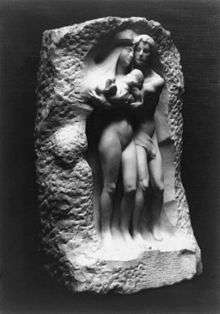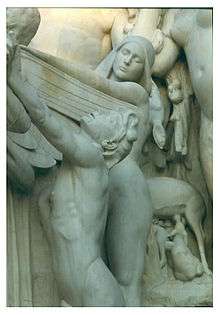George Grey Barnard
| George Grey Barnard | |
|---|---|
 Portrait of George Grey Barnard in 1908 | |
| Born |
May 24, 1863 Bellefonte, Pennsylvania, U.S. |
| Died |
April 4, 1938 (aged 74) New York City, U.S. |
| Nationality | American |
| Known for | Sculpture |
George Grey Barnard (May 24, 1863 – April 24, 1938), often written George Gray Barnard, was an American sculptor, "an excellent American sculptor", the French art dealer René Gimpel reported in his diary (1923), "very much engrossed in carving himself a fortune out of the trade in works of art."[1] His major works are largely symbolical in character.[2] His lasting monument is the architectural nucleus of The Cloisters, New York City.
Biography
Barnard was born in Bellefonte, Pennsylvania, but grew up in Kankakee, Illinois, the son of Joseph Barnard and Martha Grubb, and the grandson of his namesake George Grey Grubb. He first studied at the Art Institute of Chicago, and in 1883–1887 worked in the atelier of Pierre-Jules Cavelier at Paris while he attended the École nationale supérieure des Beaux-Arts. He lived in Paris for twelve years, and with his first exhibit at the Salon of 1894 he scored a great success, returning to America in 1896. In 1902, he was elected into the National Academy of Design as an Associate member.

A strong Rodin influence is evident in his early work. His principal works include, "The Boy" (1885); "Cain" (1886), later destroyed; "Brotherly Love," sometimes called "Two Friends" (1887); the allegorical "Two Natures" (1894, in the Metropolitan Museum, New York); "The Hewer" (1902, at Cairo, Illinois); "Great God Pan" Dodge Hall quadrangle, Columbia University campus, New York City; the "Rose Maiden"; the simple and graceful "Maidenhood". In 1912 he completed several figures for the new state capitol at Harrisburg, Pennsylvania. A larger than life-sized statue of Abraham Lincoln, in 1917, was the subject of heated controversy because of its rough-hewn features and slouching stance. The first casting is at Lytle Park in Cincinnati, Ohio (Abraham Lincoln (George Grey Barnard), 1917), the second in Manchester, England (1919), and the third in Louisville, Kentucky (1922).
The Great God Pan, one of the first works Barnard completed after his return to America, according to at least one account, was originally intended for the Dakota Apartments on Central Park West. Alfred Corning Clark, builder of the Dakota, had financed Barnard's early career; when Clark died in 1896, the Clark family presented Barnard's Two Natures to the Metropolitan Museum of Art in his memory, and the giant bronze Pan was presented to Columbia University, by Clark's son, Edward Severin Clark, 1907.


Barnard had a commanding personal manner: "He talks of art as if it were a cabalistic science of which he is the only astrologer", wrote the unsympathetic Gimpel; "he speaks to impress. He's a sort of Rasputin of criticism. The Rockefellers are his imperial family. And the dealers court him."[5]
Interested in medieval art, Barnard gathered discarded fragments of medieval architecture from French villages before World War I.[6] He established this collection in a church-like brick building near his home in Washington Heights, Manhattan in New York City. The collection was purchased by John D. Rockefeller Jr. in 1925 and forms part of the nucleus of The Cloisters collection, part of the Metropolitan Museum of Art.[7]
Barnard died following a heart attack on April 24, 1938 at the Harkness Pavilion, Columbia University Medical Center in New York. He was working on a statue of Abel, betrayed by his brother Cain, when he fell ill. He is interred at Harrisburg Cemetery in Harrisburg, Pennsylvania.
References
- ↑ Gimpel, Diary of an Art Dealer (John Rosenberg, tr.) 1966:211.
- ↑
 Rines, George Edwin, ed. (1920). "Barnard, George Grey". Encyclopedia Americana.
Rines, George Edwin, ed. (1920). "Barnard, George Grey". Encyclopedia Americana. - ↑ Catalogue of International Exhibition of Modern Art, Association of American Painters and Sculptors, Armory Show, New York. Published 1913
- ↑ The World's work, 1902-03: Barnard ar work on The Hewer
- ↑ Gimpel, Diary 15 January 1923.
- ↑ "Rare Relics Kept from America by French Protest". The New York Times. June 15, 1913.
- ↑ "The Cloisters Museum and Gardens". The Metropolitan Museum of Art.
Further reading
- Thaw, Alexander Blair (December 1902). "George Grey Barnard, Sculptor". The World's Work: A History of Our Time. V: 2837–2853. Retrieved 2009-07-10.
- Sara Dodge Kimbrough, Drawn from Life: The Story of Four American Artists Whose Friendship & Work Began in Paris During the 1880s, Jackson : University Press of Mississippi, 1976.
- Nicholas Fox Weber, The Clarks of Cooperstown: Their Singer Sewing Machine Fortune, Their Great and Influential Art Collections, Their Forty-Year Feud, New York: Alfred A. Knopf, 2007.
External links
| Wikimedia Commons has media related to George Grey Barnard. |
| Wikisource has the text of the 1911 Encyclopædia Britannica article Barnard, George Grey. |
- Kankakee County Historical Society biography.
- Chronology of George Grey's life and contributions to the art world.
- Centre County Historical Society
- George Grey Barnard at Find a Grave
- Photograph of Barnard's sculpture of Lincoln
- George Grey Barnard selected papers, 1895-1941
- George Grey Barnard papers, 1884-1963
- George Grey Barnard letters to Mr. Van der Weyde